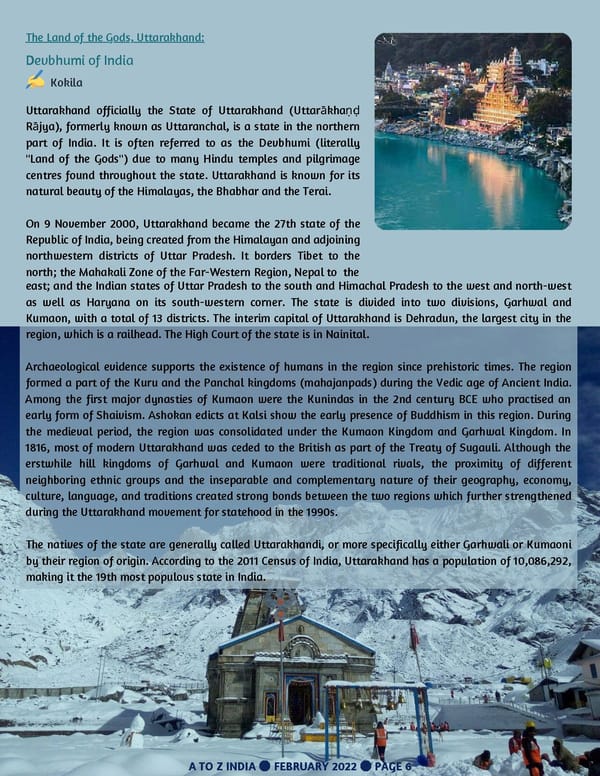Kokila A TO Z INDIA ● FEBRUARY 2022 ● PAGE 6 Devbhumi of India The Land of the Gods, Uttarakhand: Uttarakhand officially the State of Uttarakhand (Uttar ā kha ṇḍ R ā jya), formerly known as Uttaranchal, is a state in the northern part of India. It is often referred to as the Devbhumi (literally "Land of the Gods") due to many Hindu temples and pilgrimage centres found throughout the state. Uttarakhand is known for its natural beauty of the Himalayas, the Bhabhar and the Terai. On 9 November 2000, Uttarakhand became the 27th state of the Republic of India, being created from the Himalayan and adjoining northwestern districts of Uttar Pradesh. It borders Tibet to the north; the Mahakali Zone of the Far-Western Region, Nepal to the east; and the Indian stat es of Uttar Pradesh to the south and Himachal Pradesh to the west and north-west as well as Haryana on its south-w estern corner. The state is divided into two divisions, Garhwal and Kumaon, with a total of 13 districts. The interim capital of Uttarakhand is Dehradun, the largest city in the region, which is a railhead. The High Court of the state is in Nainital. Archaeological evidence supports the existence of humans in the region since prehistoric times. The region formed a part of the Kuru and the Panchal kingdo ms (mahajanpads) during the Vedic age of Ancient India. Among the first major dynasties of Kumaon were the Kunindas in the 2nd century BCE who practised an early form of Shaivism. Ashokan edicts at Kalsi show the early presence of Buddhism in this region. During the medieval period, the region was consolidated under the Kumaon Kingdom and Garhwal Kingdom. In 1816, most of modern Uttarakhand was ceded to the British as part of the Treaty of Sugauli. Although the erstwhile hill kingdoms of Garhwal and Kumaon were traditional rivals, the proximity of different neighboring ethnic groups and the inseparable and complementary nature of their geography, economy, culture, language, and traditions created strong bonds between the two regions which further strengthened during the Uttarakhand movement for sta tehood in the 1990s. The natives of the state are generally called Uttarakhandi, or more specifically either Garhwali or Kumaoni by their region of origin. According to the 2011 Census of India, Uttarakhand has a population of 10,086,292, making it the 19th most populous state in India.
 A TO Z INDIA - FEBRUARY 2022 Page 5 Page 7
A TO Z INDIA - FEBRUARY 2022 Page 5 Page 7